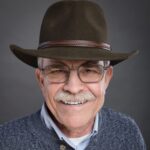George Condike saved a lot of lives in World War II, but he never wore a uniform. The year was 1944. Our flyboys were dying. The direct cause was the Germans shooting them down in the skies over Europe. The indirect cause was more mundane—light bulbs.
Condike worked at the Sylvania plant in Danvers, Massachusetts. He was a fresh-faced Ph.D. from Cornell, and he knew nothing about light bulbs. The plant had the War Department contract to make bulbs for aircraft instrument panels.
Aerial missions into enemy territory involved night flying. Squadrons flew to their targets under cover of darkness, so they could drop their bombs without being seen and shot. Pilots and navigators needed to see their instruments in the dark. Conventional lighting turned the cockpit into a flying bullseye, making it easy for enemy fighters and anti-aircraft guns to target and shoot them down.
Instead, the Army used luminous dials on the instruments, and irradiated them with invisible ultraviolet light. The dials would glow intensely under the UV light, but the cockpit would remain dark and unseen. If the UV lamps failed during a mission, the pilots resorted to visible cockpit lights. The UV lamps failed frequently, and many died when their cockpits lit up in the black skies.
The failure rate for the bulbs in combat was a serious issue. Not only were our boys perishing, but the company was in danger of losing its contract with the government. The search was on for the cause and a cure.
***
Art Sharkey glared at the manufacturing line, frustration on his grizzled face. The RP-12 bulbs jerked and wiggled down the conveyer in test mode. The faint blue glow of the ultraviolet lights cast eerie moving shadows. The string of lights paraded along in regimental fashion, a pale line of Hollywood soldiers marching tall and dimly lit—or mostly lit.
“On. On. On. Out” Sharkey as Production Manager would chant his observations for all to hear. An “on” described a functioning, lit bulb. An “out” meant the bulb was dark, the result of a failed filament. “On. On. Out!” He took a breath. “On. On. On. On. Out!” The play-by-play of electric batters up was not inspiring. His team was losing. He was furious.
Sharkey browbeat, cajoled, and pleaded with his Research and Development staff to solve the problem, but to no avail. They tried one thing, and then another. The fragile filaments burned out at an alarming rate—every fourth or fifth one never made it out of production. To make matters worse, surviving filaments frequently failed once put to the test of a combat mission. Bulbs burned out. Flyers died.
Condike never took chemistry at Brockton High, but he did spend time in a chemistry classroom. The school was short of rooms for study halls, so students without a class were sprinkled into other classes and told to sit in the back and keep quiet. George’s study hall assignments were frequently in chemistry class. He had no interest in chemistry then, but the teacher, Mr. Wigren, was loud and forceful, and he seared at least one thing into George’s brain: “When all else fails, add calcium carbonate.” The adage made no sense to George at the time. He didn’t know what calcium carbonate was, and he couldn’t care less about it.
George graduated from high school and entered a pre-med program at DePauw University. As a pre-med student, he had to take chemistry. A charismatic chemistry instructor named Jesse Riebsomer inspired him to change his major from medicine to molecules.
After DePauw, Condike continued on in chemistry at Cornell. Throughout his studies he gradually learned more about sodium carbonate. His courses included a solid foundation in descriptive chemistry, the physical and chemical properties of elements and their compounds.
***
Once again Condike and the R&D team stood next to Sharkey on the factory-viewing platform. The results of yet another failed test rolled down the production line. It was not good. It was dreadful. Bulbs flickered, flared, and flashed out. Sharkey fumed.
“Now what are we going to do?” he growled loudly over the machinery’s humming and clacking.
“When all else fails, add sodium carbonate,” George muttered to himself.
“What?” Sharkey asked. “What did you say?”
George hadn’t meant to speak out loud, but when Sharkey asked a question, he expected an answer. George had no choice but to repeat himself. “When all else fails, add sodium carbonate.”
Now he had said it, he felt compelled to explain. He thought fast, searching his memory for all he knew about the compound. “Sodium carbonate will form a flux at high temperatures. It should combine with the metal oxides and create a glassy coating. That will reduce sputtering and protect the tungsten filament.” The existing coatings were boiling off, exposing the tungsten, which rapidly deteriorated and failed. More dead fliers.
“How do you know this?”
“General knowledge, plus an old rule of thumb. I’ll bet adding five percent will do it.”
“How come you never said this before?” Sharkey gave him a skeptical look.
“I don’t know. I never thought about it. Our approach didn’t involve flux coatings. I thought maybe you had tried them.”
Sharkey was quiet for a few minutes. He was nothing if not cautious. “It’s worth a shot. Let’s try point five percent.” He didn’t normally accept suggestions from junior scientists, even Ph.D.s from Cornell, but he was desperate. “How long to make a test batch and try this?”
The R&D team figured three days.
“Make it two.” He snarled and strode away.
The team worked overtime and finished the test batch in one day. It took another day to work the batch into the production schedule. Sharkey and the R&D team anxiously waited at the end of the line. The bulbs began to appear.
Sharkey began his chant. “On. On. On. On…” He paused, and then continued, louder, “On! On! On! On!”
A few of the observers joined in. “On. On. On. On…” Soon everyone united in a chorus, “On! On! On! On!” Cheers and exclamations broke out. There were backslaps and handshakes. The team all but danced. George cried. Tears rolled down Sharkey’s cheeks.
“On to the Burn Room!” someone shouted. They all knew Sharkey and his strict procedures. Every new or changed product spent a minimum of three months in the Burn Room to prove its longevity. The gigantic room was filled with hundreds of lamps and light bulbs—low wattage, high wattage, small, large, round, tubular, clear, frosted, incandescent, fluorescent—no matter the type, it burned for three months in the Burn Room. It was Sharkey’s unbreakable rule.
The unending stream of shining bulbs projected a ghostly glow on Sharkey’s face. He wiped his eyes. He shook his head slowly, firmly, and deliberately. “No Burn Room.” He said. “No, no Burn Room.” He repeated. “Our boys are dying over there. Let’s save some lives.”
They skipped the Burn Room. They made bulbs. The planes flew. The bulbs emitted their invisible light. No more bulbs burned out in combat. No more fliers died from brilliantly lit cockpits. Sharkey beamed brighter than a two hundred watt incandescent. Condike was a corporate hero. He never received a medal, but he knew he had made a difference. He had saved lives.
Condike, now 101, reminisced. “It was all luck,” he said. “If my study hall hadn’t been in the chemistry room, I never would have solved it.”



What a story – absolutely amazing! I’m so humbled and honored to have been related to George Condike.
Truly remarkable man. We are thankful we got to meet him.
We both enjoyed reading about this feat. This should be part of the WW2 Museum in N.O.
Thanks so much for sharing.
Tubbie and Dale.
What a wonderful story. I have always held George Condike in the highest regard. He was one of the best teachers I had in college. He was brilliant and he knew how to make chemistry classes enjoyable and intriguing. It was truly heartwarming to read of his contribution to the war effort.
Brian, I thought you would like to know that your dad was admired by us all, but my dad, his older brother
was particularly pleased with who his brother had become through education. He always spoke of him as brilliant.
He admired, respected and loved him and was happy that he was able to achieve such heights.
You had a remarkable father.
Love, Gail
Wow, what a story that we did not now.
I ,too am so proud and honored to
Have known him an be a “Condike”.
Barbara Condike-Furlong
As Barbara’s sister-in-law, I am a distant voice here, but I must comment on what a hero her uncle , George Condike, was. What would we do without brilliant scientists such as he was? Having study hall in the back of a chemistry class and remembering to add “sodium carbonate” is a humorous understatement to the level of hard work and genius that he attained. Thinking of the lives he saved is overwhelming. I didn’t know your uncle, but I wish I could thank him (and his team) for all they went through to help us win the war. Jane Furlong Rawley
Interesting story! I’m sure he will be rewarded as the Lord has seen these things.
Brian,
Such a wonderful story about your Dad! He was a hero who quietly saved countless lives. So very proud to be his niece.